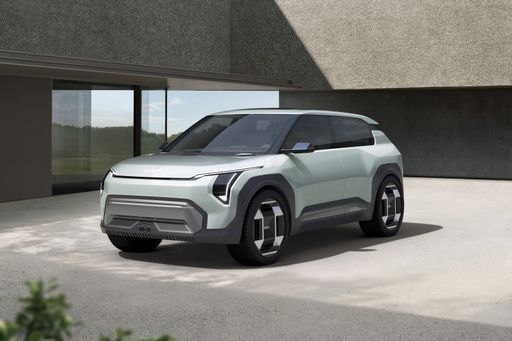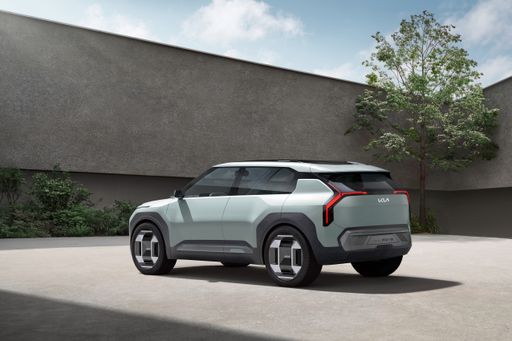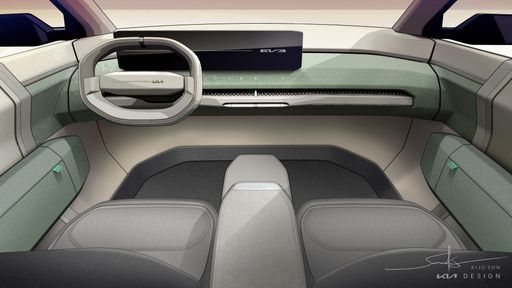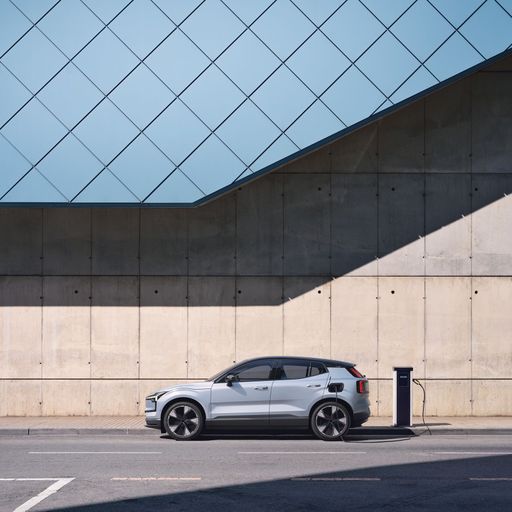The electric vehicle market continues to evolve rapidly, with manufacturers pushing boundaries in technology and performance. Two standout contenders in the compact SUV segment are the Kia EV3 and the Volvo EX30. Both vehicles boast impressive specifications and innovative features, but how do they stack up against each other? Let’s take a detailed look at their technical aspects, innovations, and overall capabilities.
Kia EV3 vs Volvo EX30 – Differences & prices compared
Two cars, one duel: Kia EV3 meets Volvo EX30.
Which one wins in performance, efficiency and value for money? Find out now!
Powertrains and Performance
The Kia EV3 comes with a front-wheel-drive layout, offering a smooth driving experience powered by a single electric motor that generates 204 HP and 283 Nm of torque. It features a choice of two battery capacities—58.3 kWh and 81.4 kWh—allowing for electric ranges between 436 km and 605 km, depending on the battery choice. With an acceleration time from 0 to 100 km/h ranging from 7.5 to 7.9 seconds, it provides a balanced blend of efficiency and performance.
On the other hand, the Volvo EX30 is available in rear-wheel-drive and all-wheel-drive configurations, depending on the variant. The base model offers 272 HP, reaching a top speed of 180 km/h, while the high-performance variant can push out an impressive 428 HP and 543 Nm of torque, achieving 0 to 100 km/h in just 3.6 seconds. The battery options include 49 kWh and 65 kWh, delivering ranges from 339 km to 476 km, catering to varied consumer needs.
Battery and Efficiency
When it comes to efficiency, the Kia EV3 excels with a consumption rate ranging from 14.9 to 16.2 kWh/100 km, making it a highly economical choice for daily driving. Its larger battery capacity allows for an extended range, making it less dependent on frequent charging.
In contrast, the Volvo EX30's consumption is slightly higher, clocking in at around 17 to 17.5 kWh/100 km. However, it compensates for this with its robust power offerings and dynamic performance. While its range falls short compared to the EV3, the driving experience and acceleration of the EX30 still position it as a compelling choice for those prioritizing performance.
Design and Dimensions
The dimensions of both SUVs reflect their compact class. The Kia EV3 measures 4300 mm in length, 1850 mm in width, and stands at a height of 1560 mm, while the Volvo EX30 is slightly smaller at 4233 mm in length, 1837 mm in width, and 1549 mm in height. Both vehicles come with five doors and can comfortably seat five passengers; however, the Kia offers a more generous trunk capacity of 460 liters compared to the Volvo's 318 liters.
Innovative Features and Technology
In terms of interior technology and safety features, both vehicles are equipped with modern infotainment systems that offer seamless connectivity, advanced driver assistance systems, and high-quality materials that enhance the driving experience. The Kia EV3 focuses on providing an intuitive user interface with abundant digital displays, while the Volvo EX30 embraces Scandinavian minimalism, integrating eco-friendly materials throughout the cabin design.
Moreover, the safety aspects of both vehicles are robust, with both brands consistently recognized for their superior safety ratings. Volvo, renowned for its safety innovations, continues to implement cutting-edge technologies, whereas Kia is significantly enhancing its safety repertoire with advanced features.
Final Thoughts
Ultimately, the choice between the Kia EV3 and the Volvo EX30 boils down to personal preference paired with specific driving needs. The Kia EV3 proves to be a champion of range and efficiency, ideal for longer commutes and eco-conscious drivers. In contrast, the Volvo EX30 appeals to those who seek exhilarating performance and dynamic driving dynamics.
Both models represent the exciting evolution of electric SUVs, highlighting the advancements in automotive technology and sustainability. As the market continues to mature, it will be fascinating to see how these two competitors evolve and influence the future of electric mobility.
Here’s where it gets real: The technical differences in detail
Costs and Efficiency:
Price and efficiency are key factors when choosing a car – and this is often where the real differences emerge.
Kia EV3 has a minimal advantage in terms of price – it starts at 30800 £, while the Volvo EX30 costs 33000 £. That’s a price difference of around 2143 £.
In terms of energy consumption, the advantage goes to the Kia EV3: with 14.90 kWh per 100 km, it’s a bit more efficient than the Volvo EX30 with 17 kWh. That’s a difference of about 2.10 kWh.
As for range, the Kia EV3 performs clearly perceptible better – achieving up to 605 km, about 129 km more than the Volvo EX30.
Engine and Performance:
Power, torque and acceleration say a lot about how a car feels on the road. This is where you see which model delivers more driving dynamics.
When it comes to engine power, the Volvo EX30 has a decisively edge – offering 428 HP compared to 204 HP. That’s roughly 224 HP more horsepower.
In acceleration from 0 to 100 km/h, the Volvo EX30 is convincingly quicker – completing the sprint in 3.60 s, while the Kia EV3 takes 7.50 s. That’s about 3.90 s faster.
In terms of top speed, the Volvo EX30 performs barely noticeable better – reaching 180 km/h, while the Kia EV3 tops out at 170 km/h. The difference is around 10 km/h.
There’s also a difference in torque: Volvo EX30 pulls decisively stronger with 543 Nm compared to 283 Nm. That’s about 260 Nm difference.
Space and Everyday Use:
Cabin size, boot volume and payload all play a role in everyday practicality. Here, comfort and flexibility make the difference.
Both vehicles offer seating for 5 people.
In curb weight, Kia EV3 is barely noticeable lighter – 1800 kg compared to 1840 kg. The difference is around 40 kg.
In terms of boot space, the Kia EV3 offers clearly perceptible more room – 460 L compared to 318 L. That’s a difference of about 142 L.
In maximum load capacity, the Kia EV3 performs evident better – up to 1251 L, which is about 251 L more than the Volvo EX30.
When it comes to payload, Kia EV3 somewhat takes the win – 470 kg compared to 390 kg. That’s a difference of about 80 kg.
Who comes out on top?
Overall, the Volvo EX30 shows itself to be dominates this comparison and secures the title of DriveDuel Champion.
It convinces with the more balanced overall package and proves to be the more versatile choice for everyday use.
 @ Volvo Cars
@ Volvo Cars
Volvo EX30
Kia EV3
The Kia EV3 arrives as a cheeky, practical electric compact that manages to feel both premium and playful, delivering crisp handling and a roomy cabin that's perfect for urban life. With smart tech, friendly styling and sensible pricing, the EV3 is the kind of car that makes switching to electric feel like a no-brainer without asking you to give anything important up.
details @ Kia Corporation
@ Kia Corporation
 @ Kia Corporation
@ Kia Corporation
 @ Kia Corporation
@ Kia Corporation
Volvo EX30
The Volvo EX30 represents a bold step forward for the brand, combining advanced technology with sustainable design principles. Its sleek and compact exterior belies a spacious interior that offers a premium driving experience. With a focus on safety and innovation, this model reflects Volvo's commitment to shaping the future of urban mobility.
details @ Volvo Cars
@ Volvo Cars
 @ Volvo Cars
@ Volvo Cars
 @ Volvo Cars
@ Volvo Cars
 @ Volvo Cars
@ Volvo Cars
 @ Volvo Cars
@ Volvo Cars
 @ Kia Corporation
@ Kia Corporation
|
 @ Volvo Cars
@ Volvo Cars
|
|
|
|
Costs and Consumption |
|
|---|---|
|
Price
30800 - 41700 £
|
Price
33000 - 49100 £
|
|
Consumption L/100km
-
|
Consumption L/100km
-
|
|
Consumption kWh/100km
14.9 - 16.2 kWh
|
Consumption kWh/100km
17 - 18.7 kWh
|
|
Electric Range
436 - 605 km
|
Electric Range
339 - 476 km
|
|
Battery Capacity
58.3 - 81.4 kWh
|
Battery Capacity
49 - 65 kWh
|
|
co2
0 g/km
|
co2
0 g/km
|
|
Fuel tank capacity
-
|
Fuel tank capacity
-
|
Dimensions and Body |
|
|---|---|
|
Body Type
SUV
|
Body Type
SUV
|
|
Seats
5
|
Seats
5
|
|
Doors
5
|
Doors
5
|
|
Curb weight
1800 - 1885 kg
|
Curb weight
1840 - 1960 kg
|
|
Trunk capacity
460 L
|
Trunk capacity
318 L
|
|
Length
4300 - 4310 mm
|
Length
4233 mm
|
|
Width
1850 mm
|
Width
1838 mm
|
|
Height
1560 - 1570 mm
|
Height
1550 - 1567 mm
|
|
Max trunk capacity
1251 L
|
Max trunk capacity
1000 L
|
|
Payload
470 kg
|
Payload
370 - 390 kg
|
Engine and Performance |
|
|---|---|
|
Engine Type
Electric
|
Engine Type
Electric
|
|
Transmission
Automatic
|
Transmission
Automatic
|
|
Transmission Detail
Reduction Gearbox
|
Transmission Detail
Reduction Gearbox
|
|
Drive Type
Front-Wheel Drive
|
Drive Type
Rear-Wheel Drive, All-Wheel Drive
|
|
Power HP
204 HP
|
Power HP
272 - 428 HP
|
|
Acceleration 0-100km/h
7.5 - 7.9 s
|
Acceleration 0-100km/h
3.6 - 5.7 s
|
|
Max Speed
170 km/h
|
Max Speed
180 km/h
|
|
Torque
283 Nm
|
Torque
343 - 543 Nm
|
|
Number of Cylinders
-
|
Number of Cylinders
-
|
|
Power kW
150 kW
|
Power kW
200 - 315 kW
|
|
Engine capacity
-
|
Engine capacity
-
|
General |
|
|---|---|
|
Model Year
2024
|
Model Year
2024 - 2025
|
|
CO2 Efficiency Class
A
|
CO2 Efficiency Class
A
|
|
Brand
Kia
|
Brand
Volvo
|
What drive types are available for the Kia EV3?
The Kia EV3 is offered with Front-Wheel Drive.
The prices and data displayed are estimates based on German list prices and may vary by country. This information is not legally binding.
